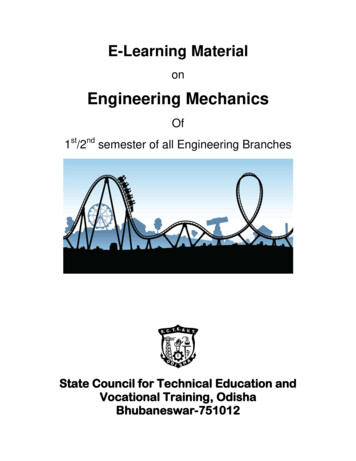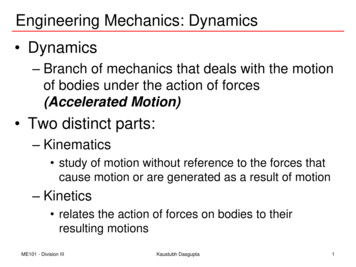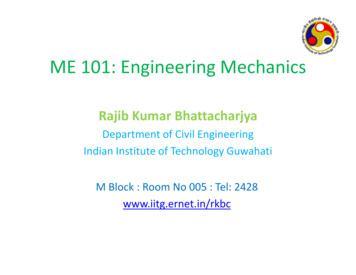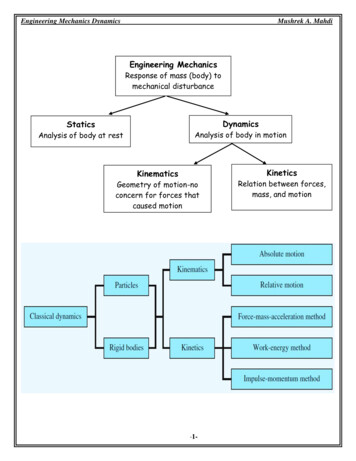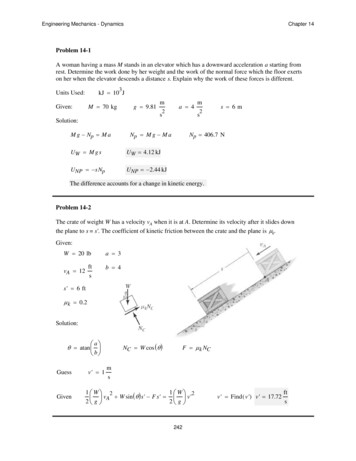
Transcription
Engineering Mechanics - DynamicsChapter 14Problem 14-1A woman having a mass M stands in an elevator which has a downward acceleration a starting fromrest. Determine the work done by her weight and the work of the normal force which the floor exertson her when the elevator descends a distance s. Explain why the work of these forces is different.3kJ 10 JUnits Used:M 70 kgGiven:g 9.81m2a 4sm2s 6msSolution:M g Np M aNp M g M aUW M g sUW 4.12 kJUNP s NpUNP 2.44 kJNp 406.7 NThe difference accounts for a change in kinetic energy.Problem 14-2The crate of weight W has a velocity vA when it is at A. Determine its velocity after it slides downthe plane to s s'. The coefficient of kinetic friction between the crate and the plane is μk.Given:W 20 lba 3ftsb 4vA 12s' 6 ftμ k 0.2Solution:aθ atan NC W cos ( θ ) b GuessGivenv' 1F μ k NCms1 W 21 W 2 vA W sin ( θ ) s' F s' v'2 g 2 g 242v' Find ( v' ) v' 17.72fts
Engineering Mechanics - DynamicsChapter 14Problem 14-3The crate of mass M is subjected to a force having a constant direction and a magnitude F, where sis measured in meters. When s s1, the crate is moving to the right with a speed v1. Determine itsspeed when s s2. The coefficient of kinetic friction between the crate and the ground is μk.Given:M 20 kgF 100 Ns1 4 mθ 30 degv1 8mss2 25 ma 1b 1m 1μ k 0.25Solution:Equation of motion: Since the crate slides, thefriction force developed between the crate and itscontact surface is F f μ kNN F sin ( θ ) M g 0N M g F sin ( θ )Principle of work and Energy: The horizontal component of force F which acts inthe direction of displacement does positive work, whereas the friction forceF f μ k ( M g F sin ( θ ) ) does negative work since it acts in the opposite directionto that of displacement. The normal reaction N, the vertical component of force Fand the weight of the crate do not displace hence do no work.F cos ( θ ) μ k N M aF cos ( θ ) μ k( M g F sin ( θ ) ) M aa vF cos ( θ ) μ k( M g F sin ( θ ) )Mdv adsv a 2.503m2s22v1v a( s2 s1 )22 v1 2 2 a( s2 s1 ) 2 v 13.004ms243
Engineering Mechanics - DynamicsChapter 14*Problem 14-4The “air spring” A is used to protect the support structure B and prevent damage to theconveyor-belt tensioning weight C in the event of a belt failure D. The force developed by thespring as a function of its deflection is shown by the graph. If the weight is W and it issuspended a height d above the top of the spring, determine the maximum deformation of thespring in the event the conveyor belt fails. Neglect the mass of the pulley and belt.Given:W 50 lbk 8000lbftd 1.5 ft2Solution:T1 U T2δ 20 W ( d δ ) k x dx 0 0Guessδ 1 in δ3 0 3 W( d δ ) k Givenδ Find ( δ )δ 3.896 inProblem 14-5A car is equipped with a bumper B designed to absorb collisions. The bumper is mounted to the carusing pieces of flexible tubing T. Upon collision with a rigid barrier at A, a constant horizontal force Fis developed which causes a car deceleration kg (the highest safe deceleration for a passenger withouta seatbelt). If the car and passenger have a total mass M and the car is initially coasting with a speedv, determine the magnitude of F needed to stop the car and the deformation x of the bumper tubing.Units Used:3Mm 10 kg3kN 10 NGiven:3M 1.5 10 kgv 1.5msk 3Solution:The average force needed to decelerate the car isF avg M k gF avg 44.1 kN244
Engineering Mechanics - DynamicsChapter 14The deformation is12M v F avg x 02T1 U12 T2x 1M2 v2 Favg x 38.2 mmProblem 14-6The crate of mass M is subjected to forces F 1 and F2, as shown. If it is originally at rest,determine the distance it slides in order to attain a speed v. The coefficient of kinetic frictionbetween the crate and the surface is μk.Units Used:3kN 10 NGiven:M 100 kgF 1 800 NF 2 1.5 kNθ 1 30 degv 6msμ k 0.2g 9.81m2sθ 2 20 degSolution:NC F 1 sin ( θ 1 ) M g F2 sin ( θ 2 ) 0NC F1 sin ( θ 1 ) M g F 2 sin ( θ 2 )NC 867.97 NT1 U12 T2F 1 cos ( θ 1 ) s μ k Nc s F2 cos ( θ 2 ) s 12Mv22s Mv2( F 1 cos ( θ 1 ) μ k NC F 2 cos ( θ 2 ) )s 0.933 mProblem 14-7Design considerations for the bumper B on the train car of mass M require use of a nonlinear springhaving the load-deflection characteristics shown in the graph. Select the proper value of k so that themaximum deflection of the spring is limited to a distance d when the car, traveling at speed v, strikesthe rigid stop. Neglect the mass of the car wheels.245
Engineering Mechanics - DynamicsChapter 14Units Used:3Mg 10 kg3kN 10 N3MN 10 kNGiven:M 5 Mgd 0.2 mv 4msSolution:d12 2M v k x dx 02 012 kdMv 2332 0k 3M v2d3k 15MNm2*Problem 14-8Determine the required height h of the roller coaster so that when it is essentially at rest at thecrest of the hill it will reach a speed v when it comes to the bottom. Also, what should be theminimum radius of curvature ρ for the track at B so that the passengers do not experience anormal force greater than kmg? Neglect the size of the car and passengers.Given:v 100kmhrk 4Solution:T1 U12 T2mgh 1 2mv221 vh 2 gh 39.3 m2kmg mg mvρ2vρ g( k 1)ρ 26.2 m246
Engineering Mechanics - DynamicsChapter 14Problem 14-9When the driver applies the brakes of a light truck traveling at speed v1 it skids a distance d1before stopping. How far will the truck skid if it is traveling at speed v2 when the brakes areapplied?Given:v1 40kmhrd1 3 mv2 80kmhrSolution:12M v1 μ k M g d1 0212M v2 μ k M g d2 02μk d2 v122g d1v2μ k 2.09722μ k gd2 12 mProblem 14-10The ball of mass M of negligible size is fired up the vertical circular track using the spring plunger.The plunger keeps the spring compressed a distance δ when x 0. Determine how far x it must bepulled back and released so that the ball will begin to leave the track when θ θ1.Given:M 0.5 kgδ 0.08 mθ 1 135 degr 1.5 mk 500g 9.81Nmm2sSolution:N 0Σ F n m anθ θ1 v2 r N M g cos ( θ ) M v 247 g r cos ( θ )v 3.226ms
Engineering Mechanics - DynamicsChapter 14x 10 mmGuessδ 12 k x dx M g r( 1 cos ( θ ) ) M v 2 x δGivenx Find ( x)x 178.9 mmProblem 14-11The force F , acting in a constant direction on the block of mass M, has a magnitude which varieswith the position x of the block. Determine how far the block slides before its velocity becomes v1.When x 0, the block is moving to the right at speed v0 . The coefficient of kinetic frictionbetween the block and surface is μk.Given:M 20 kgc 3v1 5msd 4v0 2msk 50Nmμ k 0.3g 9.812m2sSolution:NB M g Guessc 2 2 2 k x 0 c d NB M g c 2 2 2 k x c d δ 2mGiven12M v0 2δδ c2 d k x2 dx 1 M v 2 dkxx μMgδμ kk1 2 2 222 0 d dcc 0δ Find ( δ )δ 3.413 m*Problem 14-12The force F , acting in a constant direction on the block of mass M, has a magnitude whichvaries with position x of the block. Determine the speed of the block after it slides a distance d1 .When x 0, the block is moving to the right at v0 .The coefficient of kinetic friction between theblock and surface is μk.248
Engineering Mechanics - DynamicsChapter 14Given:M 20 kgc 3d1 3 md 4v0 2msk 50Nmμ k 0.3g 9.812m2sSolution:NB M g Guesscc k x2 0 N M g 2B 2 2 2 2 k x c d c d v1 2msGivend1 2 d d kxx μMgdμk1k 2 2 0 dc 12M v0 2d11c2 2 2 2 k x dx 2 M v1 c d 0v1 Find ( v1 )v1 3.774msProblem 14-13As indicated by the derivation, the principle of work and energy is valid for observers in any inertialreference frame. Show that this is so by considering the block of mass M which rests on the smoothsurface and is subjected to horizontal force F. If observer A is in a fixed frame x, determine the finalspeed of the block if it has an initial speed of v0 and travels a distance d, both directed to the right andmeasured from the fixed frame. Compare the result with that obtained by an observer B, attached tothe x' axis and moving at a constant velocity of vB relative to A. Hint: The distance the block travelswill first have to be computed for observer B before applying the principle of work and energy.Given:M 10 kgF 6Nv0 5msd 10 mvB 2msg 9.81m2s249
Engineering Mechanics - DynamicsChapter 14Solution:Observer A:1122M v0 F d M v222F Maa v2 FMa 0.6m2F dMGuess2v2 6.083mst 1ss1 2d 0 v0 t a t2Given2v0 t Find ( t)t 1.805 sObserver B:d' ( v0 vB) t 1 2at2d' 6.391 m1122M ( v0 vB) F d' M v'222Notice thatv'2 The distance that the block moves as seen byobserver B.(v0 vB)2 2F d'Mv'2 4.083v2 v'2 vBProblem 14-14Determine the velocity of the block A of weight WA if the two blocks are released from rest andthe block B of weight WB moves a distance d up the incline. The coefficient of kinetic frictionbetween both blocks and the inclined planes is μk.Given:WA 60 lbWB 40 lbθ 1 60 degθ 2 30 degd 2 ftμ k 0.10Solution:L 2sA sB0 2vA vBGuessesvA 1ftsvB 1fts250ms
Engineering Mechanics - DynamicsChapter 14Given0 2vA vB( d sin ( θ ) W d sin ( θ ) μ W cos ( θ ) d . 1 W v 2 W v 2 1B2k A1A AB B2g2 2 W A ) μ k WB cos ( θ 2 ) d vA Find ( vA , vB) vB vB 1.543ftsvA 0.771ftsProblem 14-15Block A has weight WA and block B has weight WB.Determine the speed of block A after it moves adistance d down the plane, starting from rest. Neglectfriction and the mass of the cord and pulleys.Given:WA 60 lbe 3WB 10 lbf 4d 5 ftg 32.2ft2sSolution:0 2Δ sA Δ sBL 2sA sB d W 2d B22 e f 0 W A vA e2g d WAWA 4WB 1 WA 2 1 WB 2 vA ( 2vA)2 g 2 g e2e f0 2vA vB2 2WB vA 7.178fts*Problem 14-16The block A of weight WA rests on a surface for which the coefficient of kinetic friction is μk.Determine the distance the cylinder B of weight WB must descend so that A has a speed vA startingfrom rest.251
Engineering Mechanics - DynamicsChapter 14Given:WA 3 lbWB 8 lbμ k 0.3ftsvA 5Solution:L sA 2sBd 1 ftGuessesGiven 1 vA 2WB d μ k WA2d WA vA WB 2g 2 d Find ( d)2 d 0.313 ftProblem 14-17The block of weight W slides down the inclined plane for which the coefficient of kinetic frictionis μk. If it is moving at speed v when it reaches point A, determine the maximum deformation ofthe spring needed to momentarily arrest the motion.Given:W 100 lbv 10ftsk 200lbfta 3mb 4md 10 ftμ k 0.25Solution:N b 2 2 W a b N 80 lbInitial Guessdmax 5 m252
Engineering Mechanics - DynamicsGivenChapter 1411 W 22 v μ k N( d dmax) k dmax W( d dmax) 22 g 0 a b dmax Find ( dmax)a22 dmax 2.56 ftProblem 14-18The collar has mass M and rests on the smooth rod. Two springs are attached to it and the ends of therod as shown. Each spring has an uncompressed length l. If the collar is displaced a distance s s'and released from rest, determine its velocity at the instant it returns to the point s 0.Given:M 20 kgk 50s' 0.5 mNmk' 100l 1mNmd 0.25 mSolution:11 2 122k s' k' s' M vc222vc k k' s'Mvc 1.37msProblem 14-19The block of mass M is subjected to a force having a constant direction and a magnitude F k/(a bx).When x x1, the block is moving to the left with a speed v1. Determine its speed when x x2. Thecoefficient of kinetic friction between the block and the ground is μk .Given:M 2 kgb 1m 1k 300 Nx1 4 ma 1v1 8msx2 12 mg 9.81m2sθ 30 degμ k 0.25253
Engineering Mechanics - DynamicsChapter 14Solution:NB M g x2 U x1 k sin ( θ ) 0 a b x NB M g x2 k cos ( θ )dx μ k a bx xMg k sin ( θ )dxa bxk sin ( θ )a bxU 173.177 N m11122M v1 U M v222v2 2v1 2UMv2 15.401ms*Problem 14-20The motion of a truck is arrested using a bed of loose stones AB and a set of crash barrels BC. Ifexperiments show that the stones provide a rolling resistance Ft per wheel and the crash barrelsprovide a resistance as shown in the graph, determine the distance x the truck of weight W penetratesthe barrels if the truck is coasting at speed v0 when it approaches A. Neglect the size of the truck.Given:F t 160 lbd 50 ftW 4500 lb k 1000lbftv0 60ftsg 32.23ft2sSolution:4x1 W 2 v0 4Ft d k 02 g 41 2W v02 16Ft d x k kg4x 5.444 ftProblem 14-21The crash cushion for a highway barrier consists of a nest of barrels filled with animpact-absorbing material. The barrier stopping force is measured versus the vehicle penetrationinto the barrier. Determine the distance a car having weight W will penetrate the barrier if it isoriginally traveling at speed v0 when it strikes the first barrel.254
Engineering Mechanics - DynamicsChapter 14Units Used:3kip 10 lbGiven:W 4000 lbv0 55g 32.2ftsft2sSolution:1 W 2 v0 Area 02 g Area 1 W 2 v02 g Area 187.888 kip ftWe must produce this much work with thebarrels.Assume that 5 ft x 15 ftArea ( 2 ft ) ( 9 kip) ( 3 ft) ( 18 kip) ( x 5 ft) ( 27 kip)x Area 72 kip ft 5 ft27 kipx 9.292 ftCheck that the assumption is corrrect!Problem 14-22The collar has a mass M and is supported on the rod having a coefficient of kinetic frictionμk. The attached spring has an unstretched length l and a stiffness k. Determine the speedof the collar after the applied force F causes it to be displaced a distance s s1 from pointA. When s 0 the collar is held at rest.Given:M 30 kga 0.5 mF 200 Nμ k 0.4θ 45 degs1 1.5 ml 0.2 mNk 50mg 9.81m2s255
Engineering Mechanics - DynamicsChapter 14Solution:NC 1 NGuessesv 1msGivenNC M g F sin ( θ ) 0F cos ( θ ) s1 μ k NC s1 NC Find ( NC , v) v 112 122k ( a l) k ( s1 a l) M v222NC 152.9 Nv 1.666msProblem 14-23The block of weight W is released from rest at A and slides down the smooth circular surfaceAB. It then continues to slide along the horizontal rough surface until it strikes the spring.Determine how far it compresses the spring before stopping.Given:W 5 lbμ k 0.2a 3 ftθ 90 degb 2 ftk 40lbftSolution:Guessd 1 ftGivenW a μ k W( b d) d Find ( d)1 2kd 02d 0.782 ft*Problem 14-24The block has a mass M and moves within the smooth vertical slot. If it starts from rest whenthe attached spring is in the unstretched position at A, determine the constant vertical force Fwhich must be applied to the cord so that the block attains a speed vB when it reaches sB.Neglect the size and mass of the pulley. Hint: The work of F can be determined by finding thedifference Δ l in cord lengths AC and BC and using UF F Δ l.Given:M 0.8 kgl 0.4 mmsb 0.3 mvB 2.5256
Engineering Mechanics - DynamicssB 0.15 mChapter 14k 100NmSolution:Δl Guess22l b (l sB)2 b2F 1NGivenF Δl M g sB F Find ( F)1122k sB M vB22F 43.9 NProblem 14-25The collar has a mass M and is moving at speed v1 when x 0 and a force of F is appliedto it. The direction θ of this force varies such that θ ax, where θ is clockwise, measuredin degrees. Determine the speed of the collar when x x1. The coefficient of kinetic frictionbetween the collar and the rod is μk.Given:M 5 kgF 60 Nμ k 0.3x1 3 mv1 8msg 9.81m2sa 10degmSolution:N F sin ( θ ) M gmsGuessv 5Given 112 2M v1 F cos ( a x) dx μ k F sin ( a x) M g dx M v22 0 0x1v Find ( v)x1v 10.47ms257
Engineering Mechanics - DynamicsChapter 14Problem 14-26Cylinder A has weight WA and block B has weight WB. Determine the distance A must descend fromrest before it obtains speed vA. Also, what is the tension in the cord supporting block A? Neglect themass of the cord and pulleys.Given:ftsWA 60 lbvA 8WB 10 lbg 32.2ft2sSolution:L 2sA sB0 2vA vBSystem0 WA d WB2d 1 WA 2 1 WB 2 vA ( 2vA)2 g 2 g WA 4WB 2 vA2g d WA 2WBd 2.484 ftBlock A alone1 WA 20 WA d T d vA2 g T WA WA vA2g d2T 36 lbProblem 14-27The conveyor belt delivers crate each of mass M to the ramp at A such that the crate’s velocity is vA,directed down along the ramp. If the coefficient of kinetic friction between each crate and the ramp isμk, determine the speed at which each crate slides off the ramp at B. Assume that no tipping occurs.Given:M 12 kgvA 2.5msμ k 0.3g 9.81m2sθ 30 dega 3m258
Engineering Mechanics - DynamicsChapter 14Solution:Nc M g cos ( θ )1122M vA ( M g a)sin ( θ ) μ k Nc a M vB22vB vA ( 2g a)sin ( θ ) ( 2μ k g) cos ( θ ) a2msvB 4.52*Problem 14-28When the skier of weight W is at point A he has a speed vA. Determine his speed when he reachespoint B on the smooth slope. For this distance the slope follows the cosine curve shown. Also, what isthe normal force on his skis at B and his rate of increase in speed? Neglect friction and air resistance.Given:W 150 lbvA 5ftsa 50 ftb 100 ftd 35 ftSolution: x b y ( x) ( a)cos πy'' ( x) dy' ( x)dxθ B atan ( y' ( d) )GuessesF N 1 lby' ( x) ρ ( x) dy ( x)dx(1 y' ( x) 2)3y'' ( x)ρ B ρ ( d)v' 1ftvB 12sGivenfts1 W 21 W 2 vA W( y ( 0 ft) y ( d) ) vB2 g 2 g F N W cos ( θ B)2 W vB g ρB W sin ( θ B) 259 W v' g
Engineering Mechanics - DynamicsChapter 14 vB FN Find ( vB , FN , v' ) v' vB 42.2ftsF N 50.6 lbv' 26.2ft2sProblem 14-29When the block A of weight W1 is released from rest it lifts the two weights B and C each ofweight W2. Determine the maximum distance A will fall before its motion is momentarilystopped. Neglect the weight of the cord and the size of the pulleys.Given:W1 12 lbW2 15 lba 4 ftSolution:Guessy 10 ftGivenW1 y 2W2(22)a y a 0y Find ( y)y 3.81 ftProblem 14-30The catapulting mechanism is used to propel slider A of mass M to the right along the smooth track.The propelling action is obtained by drawing the pulley attached to rod BC rapidly to the left bymeans of a piston P. If the piston applies constant force F to rod BC such that it moves it a distanced, determine the speed attained by the slider if it was originally at rest. Neglect the mass of thepulleys, cable, piston, and rod BC.Units Used:3kN 10 NGiven:M 10 kg F 20 kN d 0.2 mSolution:0 Fd 12Mv2v 2F dMv 28.284260ms
Engineering Mechanics - DynamicsChapter 14Problem 14-31The collar has mass M and slides along the smooth rod. Two springs are attached to it and the endsof the rod as shown. If each spring has an uncompressed length L and the collar has speed v0when s 0, determine the maximum compression of each spring due to the back-and-forth(oscillating) motion of the collar.Given:M 20 kga 0.25 mL 1mkA 50v0 2NmNkB 100mmsSolution:12 12M v0 ( kA kB) d 022Mv0kA kBd d 0.73 m*Problem 14-32The cyclist travels to point A, pedaling until he reaches speed vA. He then coasts freely up the curvedsurface. Determine the normal force he exerts on the surface when he reaches point B. The total massof the bike and man is M. Neglect friction, the mass of the wheels, and the size of the bicycle.Units Used:3kN 10 NGiven:vA 8msM 75 kga 4mSolution:Wheny x2y ay 1122M vA M g y M vB22Now find the radius of curvaturea4vB x y 1m2vA 2g yy avB 6.66212 x261dx 12 ymsdy 0
Engineering Mechanics - DynamicsChapter 14y xyy' xρ Thusdydxy'' xy22x(1 y' 2)Wheny xρ y''8y vB2 NB M g cos ( 45 deg) M ρ The cyclist travels to point A, pedaling untilhe reaches speed vA. He then coasts freely upthe curved surface. Determine how high hereaches up the surface before he comes to astop. Also, what are the resultant normalforce on the surface at this point and hisacceleration? The total mass of the bike andman is M. Neglect friction, the mass of thewheels, and the size of the bicycle.Given:M 75 kga 4mSolution:12M vA M g y 02x (y' a y)2yx1yρ 2.828 mProblem 14-33msy'' 3 vB2 NB M g cos ( 45 deg) M ρ vA 4y' 1y vA2y 0.815 m2gx 1.203 mθ atan ( y')θ 39.462 degNB M g cos ( θ ) 0NB M g cos ( θ )NB 568.03 NM g sin ( θ ) M atat g sin ( θ )at 6.235m2s262NB 1.697 kN
Engineering Mechanics - DynamicsChapter 14Problem 14-34The block of weight W is pressed against the spring so as to compress it a distance δ whenit is at A. If the plane is smooth, determine the distance d, measured from the wall, towhere the block strikes the ground. Neglect the size of the block.Given:W 10 lbe 4 ftδ 2 ftf 3 ftk 100lbftm2sfθ atan Solution:Guessesg 9.81 e vB 1ftst 1sd 1 ftGiven1 W 21 2kδ W f vB2 g 2 vB t Find ( vB , t , d) d d vB cos ( θ ) tvB 33.08fts0 f vB sin ( θ ) t t 1.369 s g t2 2 d 36.2 ftProblem 14-35The man at the window A wishes to throw a sack of mass M onto the ground. To do this he allows itto swing from rest at B to point C, when he releases the cord at θ θ1. Determine the speed at whichit strikes the ground and the distance R.Given:θ 1 30 degh 16 mL 8mg 9.81m2sM 30 kgSolution:0 M g L cos ( θ 1 ) 12M vC2vC 2g L cos ( θ 1 )263vC 11.659ms
Engineering Mechanics - Dynamics0 Mgh Free FlightGiven12M vD2vD t 2sGuess0 Chapter 14vD 17.7182g hR 1m g t2 v sin ( θ ) t h L cos ( θ ) C11 2 t Find ( t , R) R mst 2.078 sR vC cos ( θ 1 ) t L( 1 sin ( θ 1 ) )R 33.0 m*Problem 14-36A block of weight W rests on the smooth semicylindrical surface. An elastic cord having astiffness k is attached to the block at B and to the base of the semicylinder at point C. If theblock is released from rest at A(θ 0 ), determine the unstretched length of the cord so theblock begins to leave the semicylinder at the instant θ θ1. Neglect the size of the block.Given:W 2 lbk 2lbftθ 1 45 dega 1.5 ftg 9.81m2sSolution:Guessδ 1 ftv1 1ftsGivenW sin ( θ 1 ) W v1 g a212 12k ( π a δ ) k ( π θ 1 ) a δ W a sin ( θ 1 ) 22 v1 Find ( v1 , δ ) δ v1 5.843fts W v1 g 2δ 2.77 ft2642
Engineering Mechanics - DynamicsChapter 14Problem 14-37A rocket of mass m is fired vertically from the surface of the earth, i.e., at r r1. Assuming thatno mass is lost as it travels upward, determine the work it must do against gravity to reach adistance r2. The force of gravity is F GMem/r2 (Eq. 13-1), where Me is the mass of the earthand r the distance between the rocket and the center of the earth.Solution: Me m 2 r F G r 2 1drU12 F dr G Me m r2 r1 1 1 r2 r1 U12 G Me m Problem 14-38The spring has a stiffness k and an unstretched length l0. As shown, it is confined by theplate and wall using cables so that its length is l. A block of weight W is given a speed vA whenit is at A, and it slides down the incline having a coefficient of kinetic friction μk. If it strikes theplate and pushes it forward a distance l1 before stopping, determine its speed at A. Neglect themass of the plate and spring.Given:W 4 lbd 3 ftl0 2 ftk 50l 1.5 ftμ k 0.2l1 0.25 fta 3Solution:aθ atan GuessvA 1lbftb 4 b fts265
Engineering Mechanics - DynamicsChapter 14Given11 W 222 vA W( sin ( θ ) μ k cos ( θ ) ) ( d l1 ) k ( l0 l l1 ) ( l0 l) 022 g vA Find ( vA)vA 5.80ftsProblem 14-39The “flying car” is a ride at an amusement park which consists of a car having wheels that roll alonga track mounted inside a rotating drum. By design the car cannot fall off the track, however motionof the car is developed by applying the car’s brake, thereby gripping the car to the track and allowingit to move with a constant speed of the track, vt. If the rider applies the brake when going from B toA and then releases it at the top of the drum, A, so that the car coasts freely down along the track toB (θ π rad), determine the speed of the car at B and the normal reaction which the drum exerts onthe car at B. Neglect friction during the motion from A to B. The rider and car have a total mass Mand the center of mass of the car and rider moves along a circular path having a radius r.Units Used:3kN 10 NGiven:M 250 kgr 8mvt 3msSolution:1122M vt Mg2r M vB22vB 2vt 4 g rvB 18.0ms vB2 NB M g M r vB2 NB M g r NB 12.5 kN266
Engineering Mechanics - DynamicsChapter 14*Problem 14-40The skier starts from rest at A and travels down the ramp. If friction and air resistance can beneglected, determine his speed vB when he reaches B. Also, find the distance d to where he strikesthe ground at C, if he makes the jump traveling horizontally at B. Neglect the skier’s size. He has amass M.Given:M 70 kgh1 50 mθ 30 degh2 4 mSolution:vB 1GuessesGivenmst 1sM g( h1 h2 ) d 1mvB t d cos ( θ )12M vB2 vB t Find ( vB , t , d) d t 3.753 svB 30.0 h2 d sin ( θ ) ms 1 2gt2d 130.2 mProblem 14-41A spring having a stiffness k is compressed a distance δ. The stored energy in the spring is usedto drive a machine which requires power P. Determine how long the spring can supply energy atthe required rate.3Units Used:kN 10 NGiven:k 5Solution:1 2U12 kδ P t2kNmδ 400 mm2 1 δt k 2 P P 90 Wt 4.44 sProblem 14-42Determine the power input for a motor necessary to lift a weight W at a constant rate v.The efficiency of the motor is ε.Given:W 300 lbfv 5ftsε 0.65267
Engineering Mechanics - DynamicsP Solution:Chapter 14WvP 4.20 hpεProblem 14-43An electrically powered train car draws a power P. If the car has weight W and starts fromrest, determine the maximum speed it attains in time t. The mechanical efficiency is ε.Given:P 30 kWSolution:εP F v W 40000 lbft 30 sε 0.8W d v vg dt tv εP g v dv dt W 0 v 2ε P g tWv 29.2fts0*Problem 14-44A truck has a weight W and an engine which transmits a power P to all the wheels.Assuming that the wheels do not slip on the ground, determine the angle θ of the largestincline the truck can climb at a constant speed v.Given:W 25000 lbfv 50ftsP 350 hpSolution:F W sin ( θ )P W v θ asin P W sin ( θ ) vθ 8.86 degProblem 14-45An automobile having mass M travels up a slope at constant speed v. If mechanical friction andwind resistance are neglected, determine the power developed by the engine if the automobile hasefficiency ε.Units Used:3Mg 10 kg268
Engineering Mechanics - DynamicsChapter 14Given:M 2 Mgθ 7 degv 100kmhrε 0.65Solution:P M g sin ( θ ) vP eng PεP 66.419 kWP eng 102.2 kWProblem 14-46The escalator steps move with a constant speedv. If the steps are of height h and length l,determine the power of a motor needed to liftan average mass M per step.There are n steps.Given:M 150 kgh 125 mmn 32l 250 mmv 0.6msd nhSolution:hθ atan l P n Mgv sin ( θ )P 12.63 kWProblem 14-47If the escalator in Prob. 14 46 is notmoving, determine the constant speedat which a man having a mass M mustwalk up the steps to generate powerP—the same amount that is needed topower a standard light bulb.Given:M 80 kgh 125 mmn 32l 250 mmv 0.6msP 100 W269
Engineering Mechanics - DynamicsChapter 14Solution:hθ atan P F v sin ( θ ) l v PM g sin ( θ )v 0.285ms*Problem 14-48An electric streetcar has a weight W and accelerates along a horizontal straight road from restsuch that the power is always P. Determine how far it must travel to reach a speed of v.Given:W 15000 lbfv 40ftsP 100 hpSolution:P Fv W a v g Guessd 1 ftGivend P dsc 0 v W v2 d v g dsc W v2 dv g d Find ( d)0Problem 14-49The crate of weight W is given speed v in time t1 startingfrom rest. If the acceleration is constant, determine thepower that must be supplied to the motor when t t2.The motor has an efficiency ε. Neglect the mass of thepulley and cable.Given:W 50 lbfv 10ftst1 4 st2 2 sε 0.76g 32.2ft2sSolution:a vt1v2 a t2a 2.5ft2sftv2 5s270d 180.8 ft
Engineering Mechanics - DynamicsF W W a g Chapter 14F W P F v2 W a g P 0.49 hpF 53.882 lbfP motor PεP motor 0.645 hpProblem 14-50A car has a mass M and accelerates along a horizontal straight road from rest such that thepower is always a constant amount P. Determine how far it must travel to reach a speed of v.Solution:Power: Since the power output is constant, then the traction force F varieswith v. Applying Eq. 14-10, we haveP FvF Equation of Motion:PvP Mava Kinematics: Applying equation ds vdvaPMv, we havev s2 Mvdv 1 ds P 0 3Mvs 3P0Problem 14-51To dramatize the loss of energy in an automobile, consider a car having a weight Wcar that istraveling at velocity v. If the car is brought to a stop, determine how long a light bulb withpower Pbulb must burn to expend the same amount of energy.Given:Wcar 5000 lbfv 35mihrP bulb 100 Wg 32.2ft2sSolution:1 Wcar 2 v Pbulb t2 g 2t Wcar vt 46.2 min2g Pbulb271
Engineering Mechanics - DynamicsChapter 14*Problem 14-52Determine the power output of the draw-works motor M necessary to lift the drill pipe of weight Wupward with a constant speed v. The cable is tied to the top of the oil rig, wraps around the lowerpulley, then around the top pulley, and then to the motor.Given:W 600 lbfftsv 4Solution:P WvP 4.36 hpProblem 14-53The elevator of mass mel starts from rest and travels upward witha constant acceleration ac. Determine the power output of themotor M when t t1. Neglect the mass of the pulleys and cable.Given:mel 500 kgac 2m2st1 3 sg 9.81m2sSolution:F mel g mel acF mel( g ac)3F 5.905 10 N272
Engineering Mechanics - DynamicsChapter 14msv1 ac t1v1 6P F v1P 35.4 kWProblem 14-54The crate has mass mc and rests on a surface for which the coefficients of static and kineticfriction are μs and μk respectively. If the motor M supplies a cable force of F at2 b,determine the power output de
Engineering Mechanics - Dynamics Chapter 14 The deformation is T1 U12 T2 1 2 Mv 2 Favgx 0 x 1 2 M v 2 Favg x 38.2mm Problem 14-6 The crate of mass M is subjected to forces F1 and F2, as shown. If it is originally at rest, determine the distance it slides in order to attain a speed v. The coefficient of kinetic .



